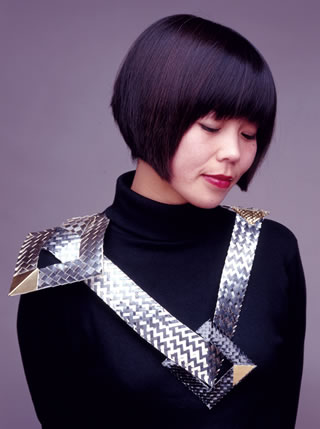The Body Beautiful - Page 4
Renk, who absorbed the Bauhaus bias against applied ornament, appreciated that plique-a-jour (‘light of day’) used enamel as a structural element in the work, not a purely decorative one.
In the 1970s, angry at the Vietnam War and upset about environmental damage, Renk’s jewelry became representational at times, even political. The change was a bit wrenching, given her background. “I was taught at the Institute of Design that using nonobjective forms was the proper way to go,” she says, “and I worked that way for years and was very happy doing it.”
But, she says, “I began thinking I could say something with jewelry too.”
“I did a family circle of the bears,” she told an oral historian, “the father bears and the mother bears, and the baby bears, interlocking in a circle, the idea that this was Ursus californicus, which is gone, disappeared from the earth.”
Renk always had an organizational streak about her—in Chicago, while still a student, she helped form and then ran (and lived at) an important, early modernist crafts gallery, the 750 Gallery.
 |
|
|
 |
|
|
In San Francisco, along with the pioneering art jeweler Margaret De Patta, Renk helped found the Metal Arts Guild in 1951. It brought together jewelers and other metal artists from around the Bay Area to share knowledge, socialize, and show their work. The group remains active today.
Among Renk’s friends in the art world was Ruth Asawa, the sculptor, who lived next door with her husband Al Lanier. Renk and Asawa spent long evenings together and watched each other’s children while the other worked. Another friend, Imogen Cunningham, used Renk, a striking presence with or without jewelry, for many of her photos, including a famous nude shot shortly before Renk gave birth.
Today, Renk is legally blind and no longer sculpts, makes jewelry, or paints. Her creative outlet is her computer, which she uses for her web site. She still clambers easily about her multi-level house.
Fisch no longer teaches but continues to create. She’s working on a series of a dozen saints, large wearable pendants. And, at the request of the Racine Art Museum, she created the largest work of her career, ‘Creatures from the Deep,’ an immense window installation that uses transparent colored wire to create more than 100 different jellyfish.
“They needed something colorful and that appealed to me,” she says.
Another installation, ‘English Garden,’ was recently shown at the San Jose Museum of Quilts and Textiles.
But Fisch hasn’t dropped wearable art.
“I don’t want to give up doing jewelry. I really enjoy doing that. It’s a way of expressing personality for people.”
Photos: David Toerge, William Gullette, Bruce Miller, Lynn Fayman, Jay Connor, Bill Hibbs, Paul Hassel, Jay Oligny; and courtesy Merry Renk and Arline Fisch collections, Los Angeles County Museum of Art, Museum of Fine Art (Boston), Forrest L. Merrill, Frank E. Cummings
- « first
- ‹ previous
- 1
- 2
- 3
- 4




